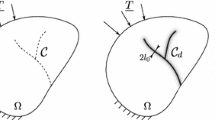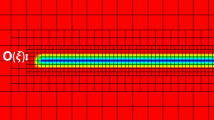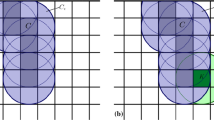Abstract
We propose an approach to the simulation of the shear-tensile transition in dynamic crack growth based on two points: a new crack propagation criterion which is suitable for shear, and an algorithm which is capable of handling the transition from shear mode to tensile mode and back in the same simulation. The new crack propagation criterion for brittle crack growth is based on the maximum shear stress rather than the maximum hoop stress. The shear stress direction becomes the new crack’s direction in which propagation is initiated for shear-type failure. The stress state at the crack’s tip is obtained through a local approach which can be used even in the case of extensive plasticity. Additionally, we propose to control the transition from shear mode to tensile mode during the simulation of crack propagation using an equivalent strain estimated at the crack’s tip. Depending on a threshold strain, the propagation direction is predicted using the maximum shear stress (in the shear case) or the maximum hoop stress (in the tensile case).
Similar content being viewed by others
References
American Society for Testing and Material (1986) A2—special requirements for testing compact specimen. ASTM E1820, US ASTM
Armero JH, Linder C (2009) Numerical simulation of dynamic fracture using finite elements with embedded discontinuities. Int J Fract 160: 119–141
Belytschko T, Chen H, Xu J, Zi G (2003) Dynamic crack propagation based on loss of hyperbolicity and a new discontinuous enrichment. Int J Numer Methods Eng 58: 1873–1905
Black T, Belytschko T (1999) Elastic crack growth in finite elements with minimal remeshing. Int J Numer Methods Eng 45: 601–620
Bordas S, Rabzuck T., Hung NX, Nguyen VP et al (2009) Strain smoothing in FEM and X-FEM. Comput Struct 98(24): 1419–1443
Bouchard PO, Bay F, Chastel Y (2003) Numerical modelling of crack propagation: automatic remeshing and comparison of different criteria. Comput Methods Appl Mech Eng 192(35–36): 3887–3908
Combescure A, Gravouil A, Grégoire D, Réthoré J (2008) X-FEM a good candidate for energy conservation in simulation of brittle dynamic crack propagation. Comput Methods Appl Mech Eng 197(5): 309–318
Cazes F, Coret M, Combescure A, Gravouil A (2009) A thermodynamic method for the construction of a cohesive law from a non local damage model. Int J Solids Struct 46: 1476–1490
Elguedj T, Gravouil A, Maigre H (2009) An explicit dynamics extended finite element method. Part 2: Element byelement stableexplicitexplicit dynamic scheme. Comput Methods Appl Mech Eng 198: 2318–2328
Elguedj T, Gravouil A, Combescure A (2005) Appropriate extended functions for X-FEM simulation of plastic fracture mechanics. Comput Methods Appl Mech Eng 198: 2318–2328
Elguedj T, Gravouil A, Maigre H (2009) An explicit dynamics extended finite element method. Part 1: mass lumping for arbitrary enrichment functions. Comput Methods Appl Mech Eng 198: 2297–2317
Erdogan F, Sih GC (1963) On the crack extension in plates under plane loading and transverse shear. J Basic Eng 85: 519–525
Europlexus web page (2010) http://europlexus.jrc.ec.europa.eu/ (March, 10th, 2010)
Francois D, Pineau A, Zaoui A (1998) Mechanical behaviour of materials, vol 2. Kluwer, Dordrecht
Fries TP, Belytschko T (2010) The extended generalized finite element method: an overview of the method and its applications. Int J Numer Methods Eng 84(3): 304–353
Grégoire D, Maigre H, Combescure A (2009) New experimental and numerical techniques to study the arrest and the restart of a crack under impact in transparent materials. Int J Solids Struct 46: 18–19
Griffith AA (1920) The phenomena of rupture and flow of solids. Philos Trans R Soc Lond Ser A Math Phys Eng 221: 163–198
Haboussa D, Grégoire D, Elguedj T, Maigre H, Combescure A (2010) X-FEM analysis of the effects of holes or other cracks on dynamic crack propagations. Int J Numer Methods Eng 46: 18–19
Ji H, Chopp D, Dolbow JE (2002) A hybrid extended finite element/level set method for modeling phase transformations. Int J Numer Methods Eng 54: 1209–1233
Kalthoff JF, Winkler S (1987) Failure mode transition at high rates of shear loading. In: Chiem CY, Kunze H-D, Meyer LW (eds) Impact loading and dynamic behavior of materials, vol 1. DGM-Verlag, Oberursel, pp 185–195
Kanninen M, Popelar C (1985) Advanced fracture mechanics. Oxford University Press, Oxford
Li S, Liu WK, Rosakis AJ, Belytschko T, Hao W (2002) Mesh-free Galerkin simulations of dynamic shear band propagation and failure mode transition. Int J Solids Struct 67: 868–893
Mazars J (1984) Application de la mecanique de l’endommagement au comportement non-lineaire et à à la rupture du beton de structure (in French). PhD thesis, ENSET, France
Menouillard T, Belytschko T (2010) Dynamic fracture with meshfree enriched XFEM. Acta Mech 213: 53–69
Menouillard T, Song JH, Duan Q, Belytschko T (2010) Time dependant crack tip enrichement for dynamic crack propagation. Int J Fract 162: 33–49
Menouillard T, Réthoré J, Combescure A, Bung H (2008a) Efficient explicit time stepping for the extended finite element method. Int J Numer Methods Eng 68: 11–38
Menouillard T, Réthoré J, Moës, Combescure A, Bung H (2008b) Mass lumping strategies for X-FEM explicit dynamics: application to crack propagation. Int J Numer Methods Eng 74(3): 447–474
Moës N, Dolbow J, Belytschko T (1999) A finite element method for crack growth without remeshing. Int J Numer Methods Eng 46: 131–150
Phongthanapanich S, Dechaumphai P (2004) Adaptive delaunay triangulation with object-oriented programming for crack propagation analysis. Finite Elem Anal Des 40(13–14): 1753–1771
Prabel B, Combescure A, Marie S (2008) Using the X-FEM method to model the dynamic propagation and arrest of cleavage cracks in ferritic steel. Eng Fract Mech 75(10): 2984–3009
Prabel B, Gravouil A, Combescure A, Marie S (2007) Level set X-FEM non matching meshes: application to dynamic crack propagation in elastic-plastic media. Int J Numer Methods Eng 69: 1553–1569
Remmers J, Borst R de, Needleman A (2003) A cohesive segments method for the simulation of crack growth. Comput Mech 31:69–77
Réthoré J, Gravouil A, Combescure A (2005) An energy-conserving scheme for dynamic crack growth using the extended finite element method. Int J Numer Methods Eng 63: 631–659
Song JH, Areias PMA, Belytschko T (2006) A method for dynamic crack and shear band propagation with phantom nodes. Int J Numer Methods Eng 67: 868–893
Wells G, Sluys L (2001) A new method for modelling cohesive cracks using finite elements. Int J Numer Methods Eng 50: 2667–2682
Williams ML (1957) On stress distribution at the base of stationary cracks. J Appl Mech 24(1): 109–114
Zhou M, Rosakis AJ, Ravichandran G (1996a) Dynamically propagating shear bands in impact-loaded prenotched plates-II. Experimental investigations of temperature signatures and propagation speed. J Mech Phys Solids 44: 981–1006
Zhou M, Rosakis AJ, Ravichandran G (1996b) Dynamically propagating shear bands in impact-loaded prenotched plates-I. Numerical simulations. J Mech Phys Solids 44: 1007–1032
Author information
Authors and Affiliations
Corresponding author
Rights and permissions
About this article
Cite this article
Haboussa, D., Elguedj, T., Leblé, B. et al. Simulation of the shear-tensile mode transition on dynamic crack propagations. Int J Fract 178, 195–213 (2012). https://doi.org/10.1007/s10704-012-9729-8
Received:
Accepted:
Published:
Issue Date:
DOI: https://doi.org/10.1007/s10704-012-9729-8




